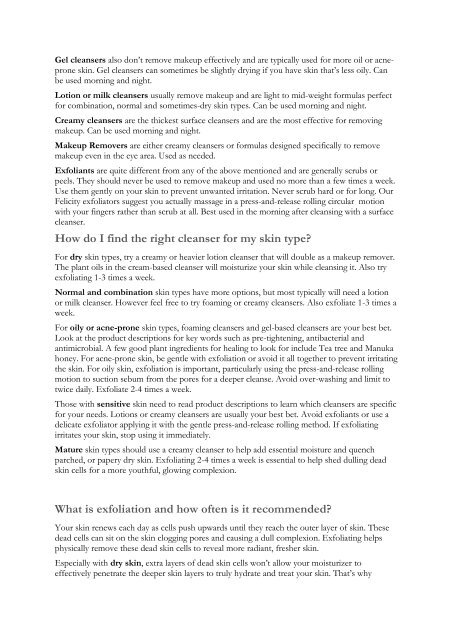FREQUENTLY ASKED QUESTIONS - Blue Oak Valley
FREQUENTLY ASKED QUESTIONS - Blue Oak Valley
FREQUENTLY ASKED QUESTIONS - Blue Oak Valley
Create successful ePaper yourself
Turn your PDF publications into a flip-book with our unique Google optimized e-Paper software.
Gel cleansers also don‟t remove makeup effectively and are typically used for more oil or acneprone<br />
skin. Gel cleansers can sometimes be slightly drying if you have skin that‟s less oily. Can<br />
be used morning and night.<br />
Lotion or milk cleansers usually remove makeup and are light to mid-weight formulas perfect<br />
for combination, normal and sometimes-dry skin types. Can be used morning and night.<br />
Creamy cleansers are the thickest surface cleansers and are the most effective for removing<br />
makeup. Can be used morning and night.<br />
Makeup Removers are either creamy cleansers or formulas designed specifically to remove<br />
makeup even in the eye area. Used as needed.<br />
Exfoliants are quite different from any of the above mentioned and are generally scrubs or<br />
peels. They should never be used to remove makeup and used no more than a few times a week.<br />
Use them gently on your skin to prevent unwanted irritation. Never scrub hard or for long. Our<br />
Felicity exfoliators suggest you actually massage in a press-and-release rolling circular motion<br />
with your fingers rather than scrub at all. Best used in the morning after cleansing with a surface<br />
cleanser.<br />
How do I find the right cleanser for my skin type?<br />
For dry skin types, try a creamy or heavier lotion cleanser that will double as a makeup remover.<br />
The plant oils in the cream-based cleanser will moisturize your skin while cleansing it. Also try<br />
exfoliating 1-3 times a week.<br />
Normal and combination skin types have more options, but most typically will need a lotion<br />
or milk cleanser. However feel free to try foaming or creamy cleansers. Also exfoliate 1-3 times a<br />
week.<br />
For oily or acne-prone skin types, foaming cleansers and gel-based cleansers are your best bet.<br />
Look at the product descriptions for key words such as pre-tightening, antibacterial and<br />
antimicrobial. A few good plant ingredients for healing to look for include Tea tree and Manuka<br />
honey. For acne-prone skin, be gentle with exfoliation or avoid it all together to prevent irritating<br />
the skin. For oily skin, exfoliation is important, particularly using the press-and-release rolling<br />
motion to suction sebum from the pores for a deeper cleanse. Avoid over-washing and limit to<br />
twice daily. Exfoliate 2-4 times a week.<br />
Those with sensitive skin need to read product descriptions to learn which cleansers are specific<br />
for your needs. Lotions or creamy cleansers are usually your best bet. Avoid exfoliants or use a<br />
delicate exfoliator applying it with the gentle press-and-release rolling method. If exfoliating<br />
irritates your skin, stop using it immediately.<br />
Mature skin types should use a creamy cleanser to help add essential moisture and quench<br />
parched, or papery dry skin. Exfoliating 2-4 times a week is essential to help shed dulling dead<br />
skin cells for a more youthful, glowing complexion.<br />
What is exfoliation and how often is it recommended?<br />
Your skin renews each day as cells push upwards until they reach the outer layer of skin. These<br />
dead cells can sit on the skin clogging pores and causing a dull complexion. Exfoliating helps<br />
physically remove these dead skin cells to reveal more radiant, fresher skin.<br />
Especially with dry skin, extra layers of dead skin cells won‟t allow your moisturizer to<br />
effectively penetrate the deeper skin layers to truly hydrate and treat your skin. That‟s why


